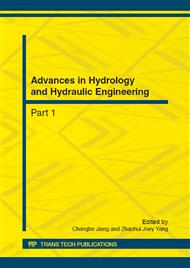p.323
p.327
p.332
p.336
p.341
p.345
p.351
p.358
p.362
Uncertainty Improvement in a Simulation of Channel Evolution
Abstract:
The Four Major Rivers Restoration Project (4MRRP), one of the largest river rehabilitation projects in Korea, has being carried out during the last three years. 0.57 billion m3 of sediment was dredged to widen and deepen the channel along four major rivers, the Han, Nakdong, Geum, and Youngsan rivers. As a result of reshaping the natural channel to a trapezoidal channel, and the construction of 16 weirs, the change of longitudinal slope of the river was inevitable. The distribution of bed materials was also changed, due to dredging. Therefore, the rivers were totally disturbed, and the stability of the rivers could not be assured. In particular, the Nakdong river, the second largest river in Korea, has the characteristics of an alluvial channel. Degradation of the main channel bed caused bank erosion, and head-cut phenomena in many tributaries. Deformations of the main channels could be observed all along the river. Long-term simulation of the channel evolution and prediction of the stability of the Nakdong river have to be examined, to cope with the instability of the river, which could lead to unexpected river disasters. This study deals with the methodology of uncertainty improvement, in analysis of the simulation and confirmation with field survey data. Methodology of uncertainty improvement in description of weir, whose discharge coefficient is unknown, in a river was suggested.
Info:
Periodical:
Pages:
341-344
Citation:
Online since:
October 2012
Authors:
Price:
Сopyright:
© 2012 Trans Tech Publications Ltd. All Rights Reserved
Share:
Citation:


